-
01-01-2016
Association between self-care and hospital readmissions of patients with heart failure
Revista Brasileira de Enfermagem. 2016;69(3):500-506
Abstract
Association between self-care and hospital readmissions of patients with heart failure
Revista Brasileira de Enfermagem. 2016;69(3):500-506
DOI 10.1590/0034-7167.2016690312i
Views0See moreABSTRACT
Objective:
to assess the association between self-care and the number of hospital readmissions of patients with heart failure (ADHF) and test the applicability of two self-care assessment tools. longitudinal study, performed in a cardiology reference hospital in southern Brazil.
Method:
it included 82 patients with a mean age of 61.85±12.33 years, 57.3% male. The mean score of self-care assessment found the scales European Heart Failure Self-care Behavior Scale and Self-care Scale for Patients with Heart Failure was unsatisfactory.
Results:
it was observed an average of 2.57±1.66 rehospitalization last year for decompensated heart failure. There was a correlation between self-care scores with the number of hospital readmissions for decompensated HF. Education and age were associated to self-care of HF patients.
Conclusion:
both scales assess self-care in a relevant way, and correlated their indexes.
-
01-01-2016
Knowledge management in Portuguese healthcare institutions
Revista Brasileira de Enfermagem. 2016;69(3):492-499
Abstract
Knowledge management in Portuguese healthcare institutions
Revista Brasileira de Enfermagem. 2016;69(3):492-499
DOI 10.1590/0034-7167.2016690311i
Views0See moreABSTRACT
Objective:
to evaluate the perception of healthcare institution collaborators in relation to knowledge management in the institution where they operate and analyze the existence of differences in this perception, based on the institution’s management model.
Method:
a study conducted in a sample consisting of 671 collaborators from 10 Portuguese healthcare institutions with different models of management. In order to assess the knowledge management perception, we used a score designed from and based on items from the scores available in the literature.
Results:
the perception of moderate knowledge management on the healthcare institutions and the statistically significant differences in knowledge management perception were evidenced in each management model.
Conclusion:
management knowledge takes place in healthcare institutions, and the current management model determines the way staff at these institutions manage their knowledge.
-
01-01-2016
Social impairment of patients undergoing hematopoietic stem cell transplant
Revista Brasileira de Enfermagem. 2016;69(3):484-491
Abstract
Social impairment of patients undergoing hematopoietic stem cell transplant
Revista Brasileira de Enfermagem. 2016;69(3):484-491
DOI 10.1590/0034-7167.2016690310i
Views0See moreABSTRACT
Objective:
to evaluate the impairment of social and emotional domains of hospitalized patients undergoing hematopoietic stem cells transplantation.
Method:
an observational, longitudinal study with 25 participants evaluated in the period of pre-transplant, pancytopenia and pre-hospital discharge between September 2013 and September 2014, in a reference hospital for this treatment modality in Brazil. Two international instruments were used, both of which translated and adapted to Portuguese (Brazil): Quality of Life Questionnaire-Core 30 and Functional Assessment Cancer Therapy – Bone Marrow Transplantation.
Results:
patients have shown a statistically significant decrease in the social domain, and stability of the emotional function along the course of treatment.
Conclusion:
hematopoietic stem cell transplantation changes the social function of patients with hematologic cancer during hospitalization stage. Thus, patients should receive guidance addressing the social domain in order that it can be less affected.
-
01-01-2016
Frailty and quality of life in elderly primary health care users
Revista Brasileira de Enfermagem. 2016;69(3):478-483
Abstract
Frailty and quality of life in elderly primary health care users
Revista Brasileira de Enfermagem. 2016;69(3):478-483
DOI 10.1590/0034-7167.2016690309i
Views1See moreABSTRACT
Objective:
to investigate the association between physical frailty and quality of life in elderly users of primary health care in the capital of the state of Paraná.
Method:
a cross-sectional, quantitative study with 203 elders. Data collected included: physical activity questionnaires, weight loss, fatigue/exhaustion, quality of life, performance of gait speed tests, and handgrip strength.
Results:
of the 203 older adults, 115 were pre-frail, 49 were non-frail, and 39 were frail, with a significant association with functional capacity and quality of life in all groups. The dimensions resulting from physical aspects, pain, and vitality were associated with those that were non-frail.
Conclusion:
in this study, frailty syndrome was inversely proportional to the quality of life, and significantly associated with functional capacity of older adults. Physical frailty is a manageable condition which can be targeted through geriatric nursing interventions.
-
01-01-2016
Impact of home visits on the functional capacity of patients with venous ulcers
Revista Brasileira de Enfermagem. 2016;69(3):468-477
Abstract
Impact of home visits on the functional capacity of patients with venous ulcers
Revista Brasileira de Enfermagem. 2016;69(3):468-477
DOI 10.1590/0034-7167.2016690308i
Views0See moreABSTRACT
Objective:
to assess the impact of protocol home visits on the functional capacity of adult and elderly patients with venous ulcers, before and after guidance received at home.
Method:
clinical experimental, randomized, nonblinded and controlled study, developed with 32 patients (case and control groups). Fields of research were the Wound Outpatient Care Unit of the Antônio Pedro University Hospital and households of patients treated in the outpatient unit. Data collection occurred from February to June 2014, by means of an assessment tool of the health care unit, the TINETTI index and a script for directions to be provided to study participants who received home visits.
Results:
participants in the case group showed significant and differentiated improvement post-intervention when compared to the control group, which remained stable.
Conclusion:
directions provided in the home context were beneficial to the members of the case group.
-
01-01-2016
Pressure ulcers in critically ill patients: incidence and associated factors
Revista Brasileira de Enfermagem. 2016;69(3):460-467
Abstract
Pressure ulcers in critically ill patients: incidence and associated factors
Revista Brasileira de Enfermagem. 2016;69(3):460-467
DOI 10.1590/0034-7167.2016690307i
Views0See moreABSTRACT
Objective:
to identify the incidence and describe the associated factors for pressure ulcers in critically ill patients.
Method:
this was a prospective cohort study with 77 patients, using a clinical, metabolic assessment and the associated factors for pressure ulcer, applying the risk scales (Braden and Waterlow) and assigning ulcers to categories.
Results:
an incidence of 22% (95% CI 12.6 – 31.5), with 17 patients with 32 pressure ulcers in the sacral region (47%), and of Class I (72%). The length of stay was greater than ten days (71%), most admissions were surgical (53%) or for congestive heart failure (24%), and were high risk on the Braden Scale (59%).
Conclusion:
the study highlights the high incidence of pressure ulcers, clinical and metabolic characteristics and associated factors, as well as the outcome of death, requiring, therefore, preventive measures.
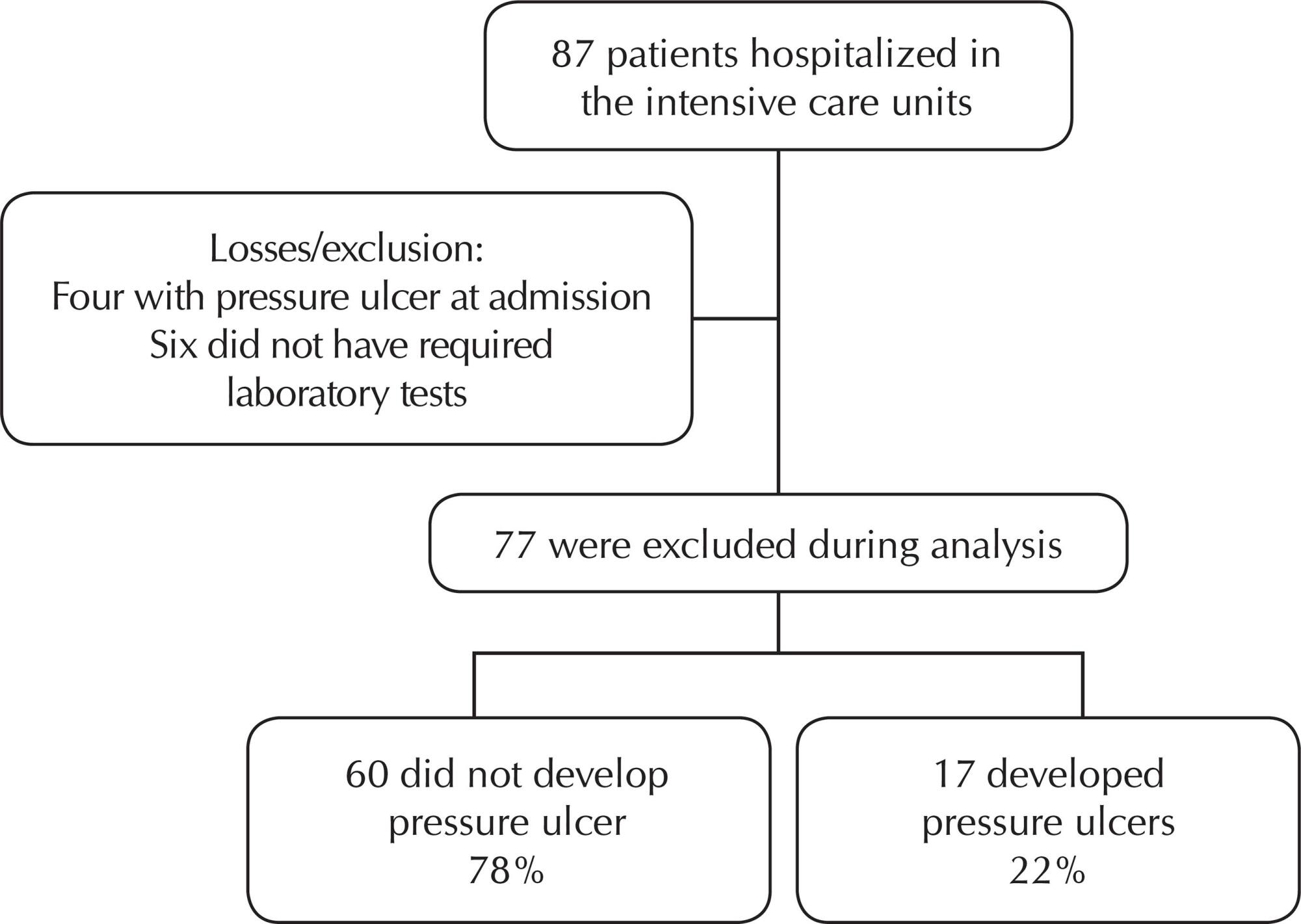
-
01-01-2016
Accreditation in a public hospital: perceptions of a multidisciplinary team
Revista Brasileira de Enfermagem. 2016;69(3):451-459
Abstract
Accreditation in a public hospital: perceptions of a multidisciplinary team
Revista Brasileira de Enfermagem. 2016;69(3):451-459
DOI 10.1590/0034-7167.2016690306i
Views1See moreABSTRACT
Objective:
to analyze the perceptions of the multidisciplinary team on Accreditation in a public hospital.
Method:
descriptive, exploratory, qualitative research, performed in May 2014, using recorded individual interviews. In total, 28 employees of a public hospital, Accredited with Excellence, answered the guiding question: “Tell me about the Accreditation system used in this hospital”. The interviews were transcribed and subjected to content analysis.
Results:
of the speeches, three categories emerged: Advantages offered by the Accreditation; Accredited public hospital resembling a private hospital; Pride/satisfaction for acting in an accredited public hospital.
Conclusion:
participants perceived Accreditation as a favorable system for a quality management in the public service because it promotes the development of professional skills and improves cost management, organizational structure, management of assistance and perception of job pride/satisfaction.
-
01-01-2016
Health status and the return to work after traffic accidents
Revista Brasileira de Enfermagem. 2016;69(3):443-450
Abstract
Health status and the return to work after traffic accidents
Revista Brasileira de Enfermagem. 2016;69(3):443-450
DOI 10.1590/0034-7167.2016690305i
Views0See moreABSTRACT
Objective:
to compare the health status of traffic accident victims, at hospital discharge and after six months, and to analyze the predictive variables of their health status and return to work.
Method:
observational, longitudinal study. Data were collected through interviews and medical records of 102 patients with a mean age of 33 years; with the majority being men and victims of motorcycle accidents. The variables were analyzed by means of validated tools, student’s t-test, multiple linear regression, and logistic regression.
Results:
there was an improvement of perception in the patients’ health status six months after hospital discharge and functional capacity. The individuals who returned to work showed better health-related quality of life evaluation.
Conclusion:
improvement of the perceived health status six months after hospital discharge was found. Factors that influenced the patients’ return to work were not identified.
-
ORIGINAL ARTICLE12-13-2019
Accessibility of children with special health needs to the health care network
Revista Brasileira de Enfermagem. 2019;72:65-71
Abstract
ORIGINAL ARTICLEAccessibility of children with special health needs to the health care network
Revista Brasileira de Enfermagem. 2019;72:65-71
DOI 10.1590/0034-7167-2017-0899
Views0See moreABSTRACT
Objective:
To know how children with special health needs access the health care network.
Method:
This is a qualitative research of descriptive-exploratory type, developed using semi-structured interviews mediated by the Talking Map design. Participants were 19 family caregivers of these children in two Brazilian municipalities. Data were submitted to inductive thematic analysis.
Results:
Difficulties were mentioned from the diagnosis moment to the specialized follow-up, something represented by the itinerary of the c hild and his/her family in the search for the definition of the medical diagnosis and the access to a specialized professional; a gap between the children’s needs and the care offered was observed in primary health care.
Conclusion:
The access of children with special health needs is filled with obstacles such as slowness in the process of defining the child’s diagnosis and referral to a specialist. Primary health care services were replaced by care in emergency care units.
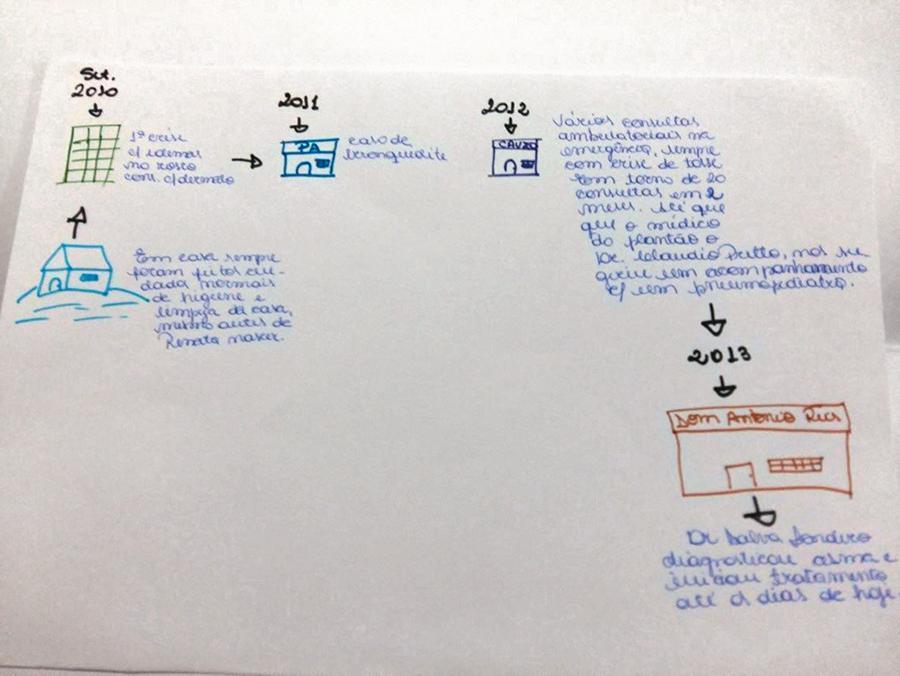
-
08-19-2019
Humor intervention in the nurse-patient interaction
Revista Brasileira de Enfermagem. 2019;72(4):1078-1085
Abstract
Humor intervention in the nurse-patient interaction
Revista Brasileira de Enfermagem. 2019;72(4):1078-1085
DOI 10.1590/0034-7167-2018-0609
Views0ABSTRACT
Objective:
To describe the factors influencing the use of humor in nursing care, its applicability and benefits.
Method:
A scoping review was performed using the Arksey and O’Mally methodology. A search for articles published between 2008 and 2018 was performed using the platforms EBSCO Host, Virtual Health Library and Google Scholar.
Results:
From the initial 465 articles found, 17 were included for final revision. Data allowed to retrieve information on humor definition; its applicability as a nursing intervention; humor as a tool to improve nurse-patient communication and relationship; influence factors; type of humor interventions; humor benefits in health care context and; limitations and precautions of humor intervention.
Conclusion:
The use of humor promotes both communication and human interaction; it promotes well-being; helps deal/cope with difficult and unpleasant situations, reduces tension, discomfort and stress; and strengthens the immune system. This intervention should be used with caution.
Keywords:CommunicationNurse-Patient RelationsNursingPatient Outcome AssessmentWit and Humor as SubjectSee more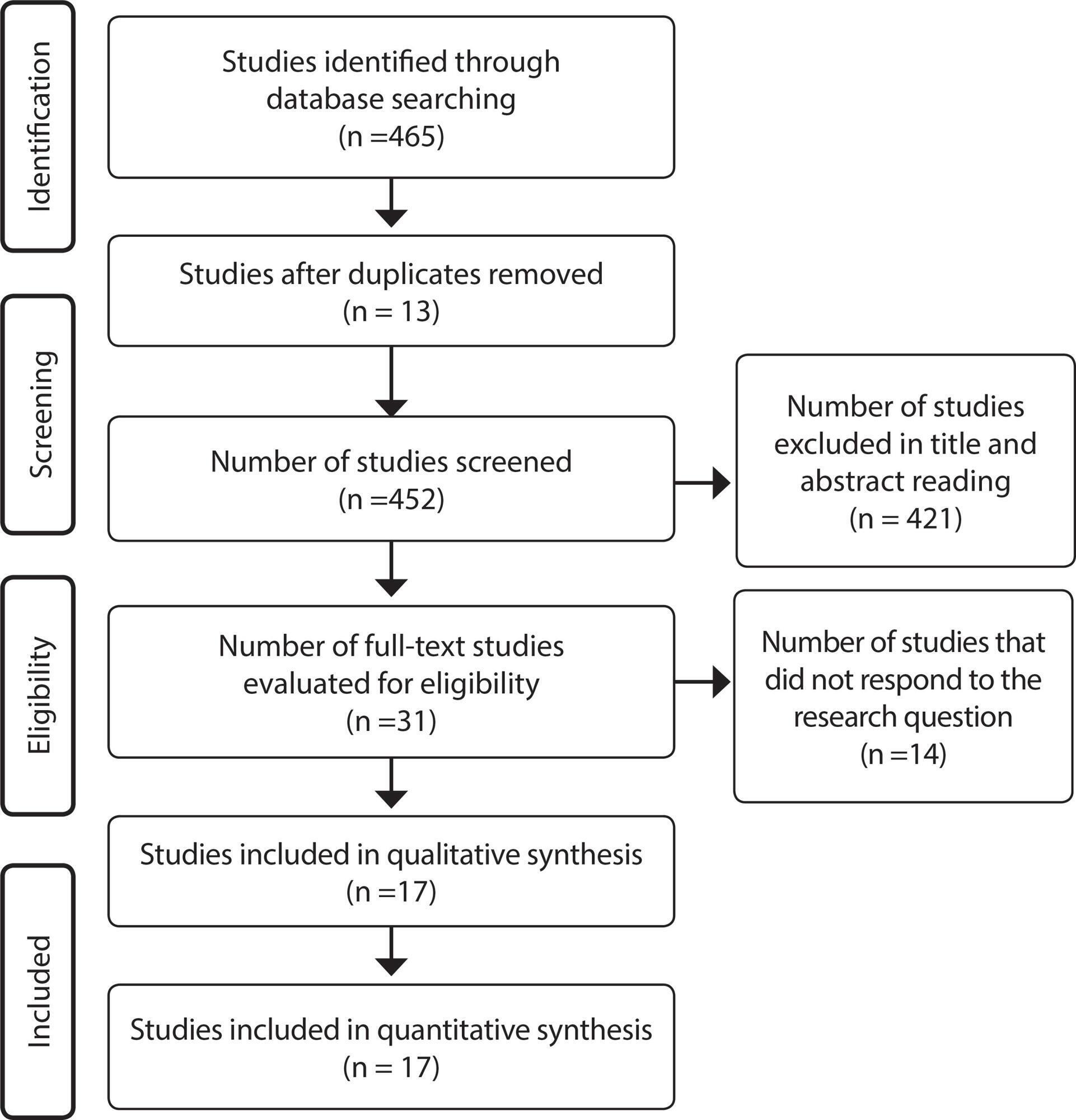
-
ORIGINAL ARTICLE07-13-2020
Incontinence-associated dermatitis in elderly patients: prevalence and risk factors
Revista Brasileira de Enfermagem. 2020;73:e20180475
Abstract
ORIGINAL ARTICLEIncontinence-associated dermatitis in elderly patients: prevalence and risk factors
Revista Brasileira de Enfermagem. 2020;73:e20180475
DOI 10.1590/0034-7167-2018-0475
Views0See moreABSTRACT
Objective:
To determine the prevalence and risk factors for incontinence-associated dermatitis in the elderly.
Method:
Cross-sectional exploratory study carried out in public hospitals. The dermatitis prevalence and associations were obtained by calculating the ratio. The effect dimension was estimated by the odds ratio with a 95% confidence interval and statistical significance p <0.05.
Results:
138 elderly people were included, with an average age of 77.2 years old (± 9.3); 69 (50%) had combined fecal and urinary incontinence. The dermatitis prevalence was 36.2% (50); 28% (14) had pressure injuries; 14% (7), candidiasis. Risk factors were: longer hospital stay (Odds Ratio = 5.8 [2.6-12.9]), obesity (Odds Ratio = 3.6 [1.2-10.4]), high level of dependence (Odds Ratio = 2.4 [1,1-5,0]) and high risk for pressure injury (Odds Ratio = 6.1 [1,4-26,9]).
Conclusion:
The study found a high prevalence of dermatitis associated with incontinence. The early recognition of risk factors favors effective preventive actions.
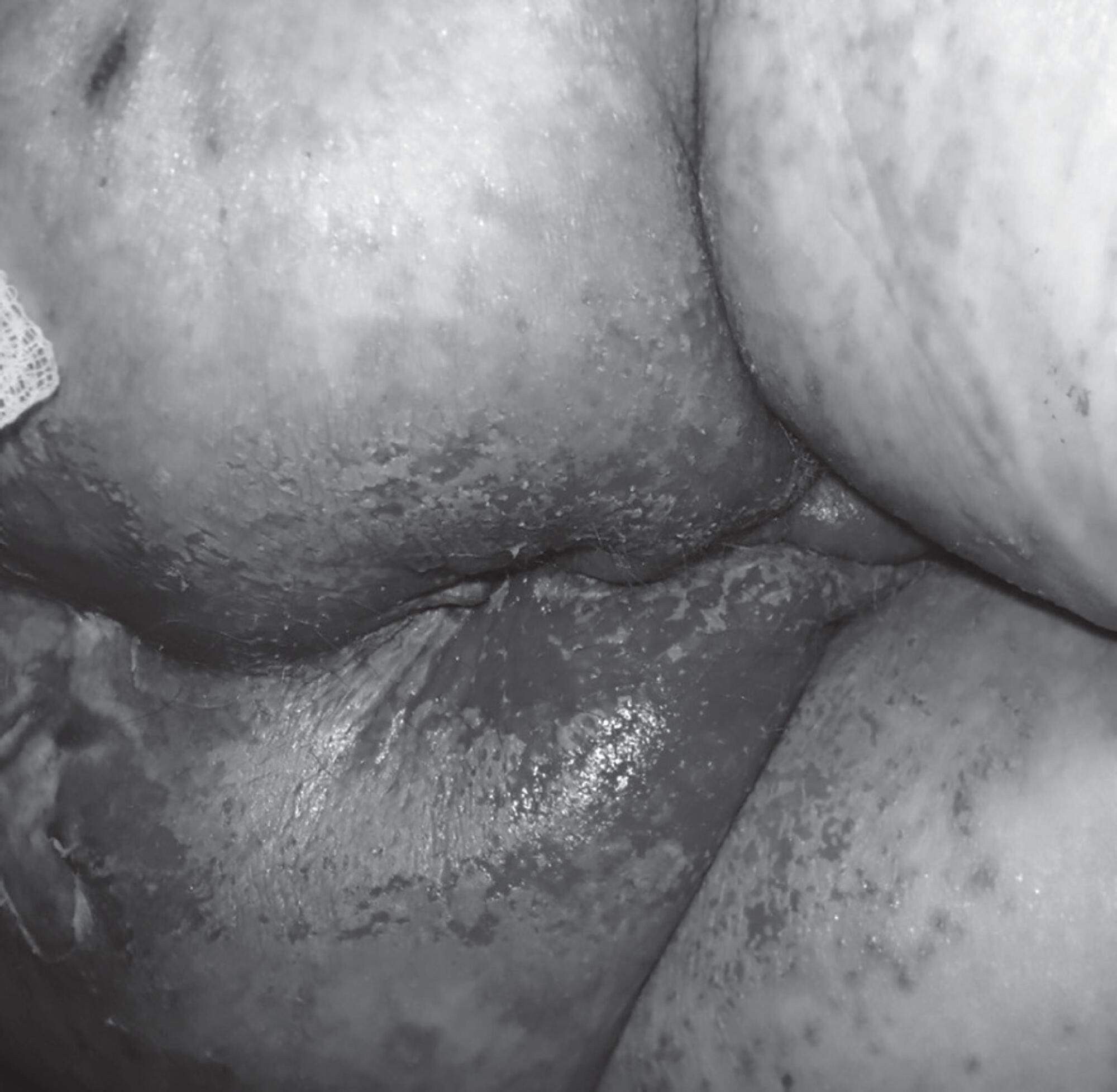
-
ORIGINAL ARTICLE10-21-2019
Workloads and burnout of nursing workers
Revista Brasileira de Enfermagem. 2019;72(6):1435-1441
Abstract
ORIGINAL ARTICLEWorkloads and burnout of nursing workers
Revista Brasileira de Enfermagem. 2019;72(6):1435-1441
DOI 10.1590/0034-7167-2017-0659
Views0See moreABSTRACT
Objective:
to identify workloads in nursing work and its association with nursing worker burnout.
Method:
a cross-sectional study, including 211 nursing workers from a university hospital, between July and August 2016. For the analysis, the descriptive statistics, Chi-Square Test, Fisher’s Exact Test and Mann Whitney U-Test were used.
Results:
the most evidenced loads were biological. A significant association was found between workloads and workers’ occupation, as well as a significant association between workloads and worker burnout. Burnout caused upper limb pain, neck and lumbar pain, lower limb pain, muscle spasm, lower limb edema, mental fatigue, headache, nervousness, and forgetfulness.
Conclusion:
workloads identification is a subsidy for the promotion of interventions that minimize the burnout generated to the health of the nursing worker.
-
ORIGINAL ARTICLE10-21-2019
Nursing care systematization: perceptions and knowledge of the Brazilian nursing
Revista Brasileira de Enfermagem. 2019;72(6):1547-1553
Abstract
ORIGINAL ARTICLENursing care systematization: perceptions and knowledge of the Brazilian nursing
Revista Brasileira de Enfermagem. 2019;72(6):1547-1553
DOI 10.1590/0034-7167-2018-0606
Views0See moreABSTRACT
Objective:
to present the perception and knowledge of Brazilian nursing nurses and academics regarding Nursing Care Systematization.
Method:
a descriptive study, carried out in the first half of 2018.
Results:
of the 596 respondents, 86% perceived Nursing Care Systematization as very important, but only 60.9% used it in their care practice. Its use was statistically associated with a higher level of training. Non-utilization was associated with the perception that it is irrelevant and with little knowledge on the Nursing Process, even in the face of recognition of its obligation. Among professionals who wish to learn more about the subject, understanding the application of the process, especially the planning step, is perceived as a necessity.
Conclusion:
the relevance perception of systematization and levels of knowledge of the professional/academic are directly related to the use or not of Nursing Care Systematization principles.

-
REVIEW12-05-2019
Vulnerability of the elderly: a conceptual analysis
Revista Brasileira de Enfermagem. 2019;72:337-344
Abstract
REVIEWVulnerability of the elderly: a conceptual analysis
Revista Brasileira de Enfermagem. 2019;72:337-344
DOI 10.1590/0034-7167-2018-0728
Views0See moreABSTRACT
Objective:
To analyze the concept of vulnerability of the elderly.
Method:
A concept analysis, according to the method proposed by Walker and Avant, operationalized through integrative review through search in scientific data portals using the
Descriptors:
Health vulnerability, aged, health services for the aged, health of the elderly, vulnerable populations and geriatric health services. To compose the literary corpus, 36 studies were selected.
Results:
Concept antecedents, as well as its attributes, were identified in individual, social and programmatic characteristics, which make up the characteristics of “vulnerability of the elderly”, besides consequences of the phenomenon. These characteristics were analyzed with emphasis on aspects that contribute to the process of vulnerability of the elderly.
Conclusion:
The study demonstrated the multidimensionality of the phenomena studied, highlighting the peculiarities of vulnerability during aging. However, there is a need for further studies on the construct.
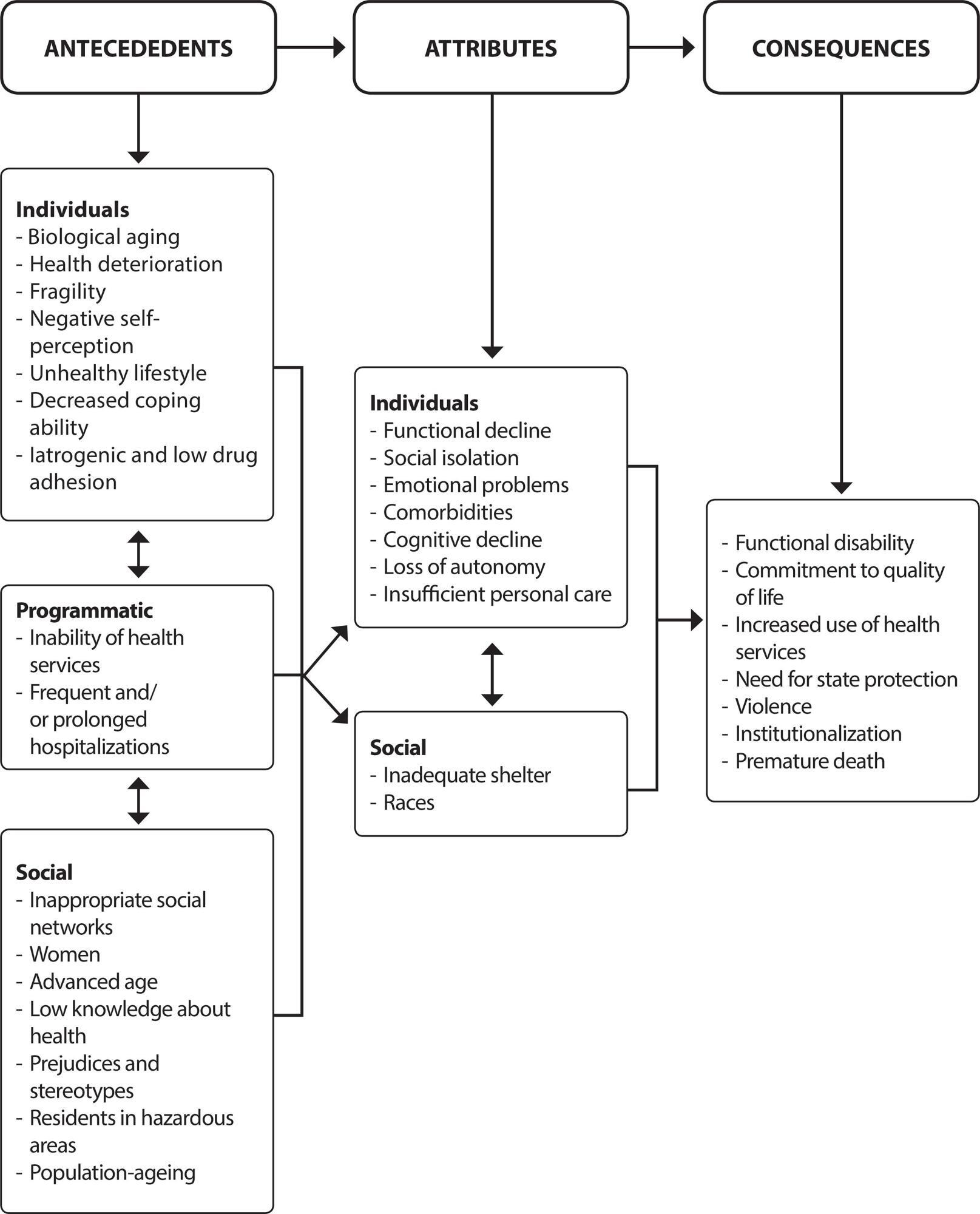
-
01-20-2021
Burnout Syndrome and Associated Factors in Intensive Care Unit Nurses
Revista Brasileira de Enfermagem. 2021;74:e20190535
Abstract
Burnout Syndrome and Associated Factors in Intensive Care Unit Nurses
Revista Brasileira de Enfermagem. 2021;74:e20190535
DOI 10.1590/0034-7167-2019-0535
Views0See moreABSTRACT
Objective:
to estimate prevalence and factors associated with Burnout Syndrome in intensive care nurses in a city in the state of Bahia.
Methods:
a cross-sectional, population-based study carried out with 65 intensive care nurses through a self-administered questionnaire, from July to November 2016, containing sociodemographic data, lifestyle, work characteristics. To define burnout syndrome, the Maslach Burnout Inventory was used.
Results:
Burnout Syndrome prevalence was 53.6%, an association was observed with age, tobacco consumption, alcohol use, weekly night shift hours, employment relationship, having an intensive care specialist title, number of patients on duty, monthly income and considering active or high-strain job.
Conclusion:
the results of this study can contribute to expanding the discussion on stressful working conditions in Intensive Care Units.
-
08-19-2019
Clinical simulation in nursing education in intensive therapy: an integrative review
Revista Brasileira de Enfermagem. 2019;72(4):1061-1070
Abstract
Clinical simulation in nursing education in intensive therapy: an integrative review
Revista Brasileira de Enfermagem. 2019;72(4):1061-1070
DOI 10.1590/0034-7167-2018-0217
Views0See moreABSTRACT
Objective:
to analyze the publications on clinical simulation practices for education in Nursing in Intensive Care.
Method:
an integrative review carried out through LILACS, PubMed, Cochrane Library, CINAHL and SciELO databases, of articles published from 2008 to 2017.
Results:
29 articles were selected, of which 76% discuss the use of simulation in continuing education of nursing professionals, while the others describe their use for student education. There is a higher prevalence of studies with a level of evidence 6 (17), with 28 international publications. There was an increase in scientific production, with 16 articles published in the last three years.
Conclusion:
variables after simulation use, such as confidence, communication skills, efficiency in the identification of clinical worsening of patients, development of technical skills, teamwork and clinical decision-making, presented a significant improvement, demonstrating that this tool is effective in qualifying care for critical patients.
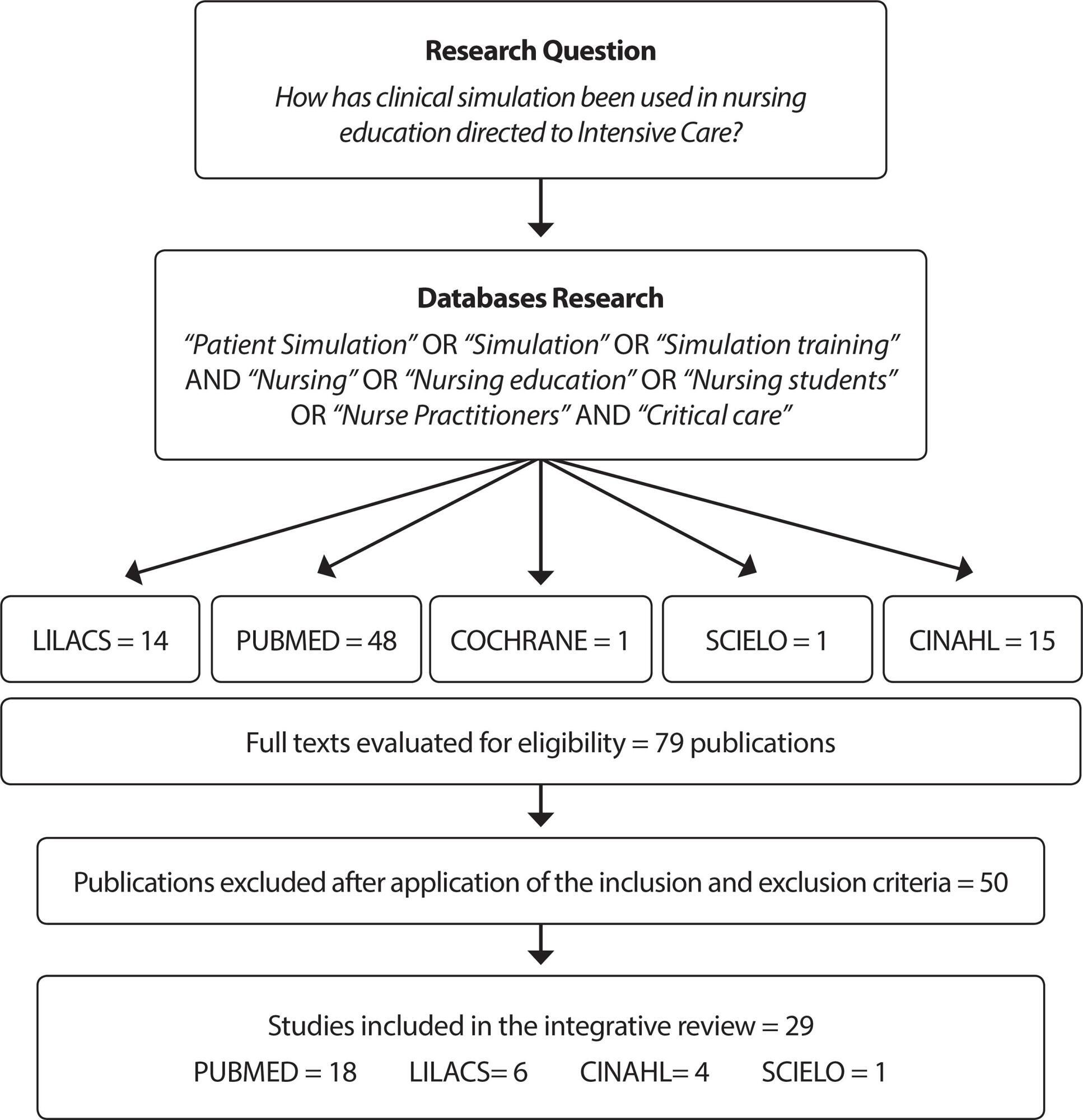
Search
Search in:
Nuvem de Tags
Enfermagem (930)Cuidados de Enfermagem (269)Atenção Primária à Saúde (239)Idoso (208)Educação em Enfermagem (151)Segurança do Paciente (150)Saúde Mental (145)Educação em Saúde (139)Estudos de Validação (131)Qualidade de Vida (104)Tecnologia Educacional (100)Promoção da Saúde (99)COVID-19 (91)Criança (91)Família (87)Enfermagem Pediátrica (86)Saúde do Trabalhador (86)Adolescente (85)Saúde Pública (82)Estudantes de Enfermagem (77)



